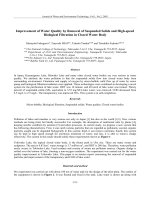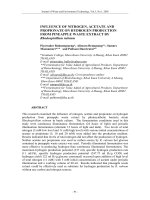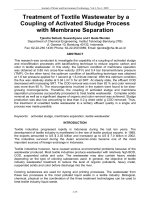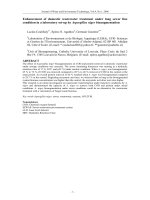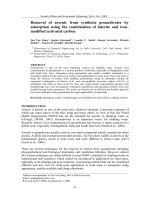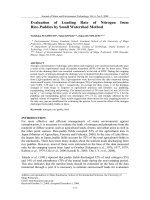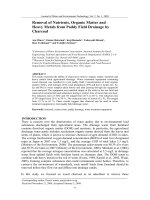Removal of congo red from wastewater by adsorption onto waste red mud
Bạn đang xem bản rút gọn của tài liệu. Xem và tải ngay bản đầy đủ của tài liệu tại đây (593.16 KB, 17 trang )
Vol. 34. No. 2, pp. 401417,
1997
Copyright 0 1997 Elsevier Science Ltd
Printed in Great Britain. All rights reserved
0045.6535/97
$17.00+0.00
Chemosphere,
PII: SOO45-6535(96)00385-Z
REMOVAL
OF CONGO
RED FROM
WASTEWATER
BY ADSORPTION
ONTO WASTE RED MUD
C. NAMASIVAYAM*
and D. J. S. E. ARASI
Environmental
Chemistry Division
Department of Environmental
Sciences
Bharathiar University
Coimbatore - 641 046
Tamil Nadu - INDIA.
(Received in USA 23 June 1996; accepted 23 August 1996)
ABSTRACT
Waste
generated
for
during
the
red
the
adsorption
Adsorption
as dye concentration,
data
The
isotherms.
dye
was
quantitative
suggest
that
exchange.0
Key
words
first
mg/g.
the
Elsevier
: Waste
red
the
solution.
parameters
agitation
time
Author
E-mail:
to whom
and pH.
equilibrium
both
Langmuir
and
Freundlich
capacity
of
was
the
found
of pH and
of
Science
congo
red,
All
to
mud
be
desorption
adsorption
Ltd.
red
is
rights
adsorption
correspondence
should
sandflas250.bharathi.ernet.in
401
for
the
nearly
studies
mostly
ion
reserved
isotherms
pH effect.
*
such
The
Effect
mud,
is recycled
expression.
mechanism
1997
dose,
ore,
aqueous
using
Adsorption
2.0.
from
byproduct,
rate
obeyed
at pH
red
studied
adsorption
4.05
of bauxite
adsorbent
followed
adsorption
congo
were
industrial
an
processing
of
kinetics
Adsorption
mud,
be addressed.
402
INTRODUCTION
Colour
is
one
of
the
characteristics
of
an
effluent which is easily detected and readily traced back to
its source. Most dyes are stable to biological degradation.
Coloured waters are often objectionable on aesthetic grounds
for drinking and other agricultural purposes. Colour affects
the nature of the water by inhibiting sunlight penetration
thus
reducing
carcinogenic
photosynthetic
and mutagenic
action.
Some
(1). Hence there
dyes
are
is a need to
remove dyes from wastewaters before it mixing with receiving
waters.
The treatment of dyes in industrial wastewaters
poses several problems
photodegradation
treated
by
the
Activated
available.
adsorbent
is
carbon
and has
of
aerobic
an attractive
adsorbent
stable to
(2); hence, they cannot be
methods
of dyes provides
if
popular
and oxidation
conventional
Adsorption
removal
since dyes are generally
been
alternative
inexpensive
the
most
used
with
is
digestion.
readily
and
efficient
great
for
and
success.
However, high costs in the procurement of activated carbon
restricts
its
Namasivayam
adsorbents
These
(3)
in
has
developing
recently,
countries
reviewed
like
India.
non-conventional
used for the removal of dyes and heavy metals.
include
residual
use
slurry
agricultural
(4),
banana
solid
pith
wastes
such
(5), orange
as
biogas
peel
(6),
403
bagasse
as
and
paddy
straw
Fe(III)/Cr(III)
Namasivayam
of dairy
(11)
and coworkers
from
employed
solutions.
of using
containing
congo
fly
ash
and
coal(g).
et
al.
(12)
have
of nickel.
of this
a textile
such
of chlorophenol
study
was to evaluate
red mud for the treatment
red,
waste
red mud for the treatment
Zouboulis
for the removal
The objective
feasibility
and
solid
(10) and for the removal
aqueous
red mud
industrial
hydroxide(8)
wastewater
employed
(7) and
the
of wastewater
dye as a typical
case
(13).
EXPERIMENTAL
Materials
Waste
Aluminium
the
at
Factory
adsorbent.
water
for
red
Tamil
Nadu,
powder
was
was
obtained
from
M/S
India)
was
washed
particulate
fine
The
obtained
thoroughly
was
very
5 h.
Congo
studies.
mud
(Mettur,
It
to remove
60°C
red
used
used
CIBA
for
as
distilled
( < 53 /A) and
then
from
with
Mettur
dried
adsorption
- GEIGY
(Bombay,
India).
Methods
Batch
by agitating
250
mg
of
adsorption
50 mL of dye
adsorbent
temperature
(30
solution
separated
at
8,600
was
x
g.
?
in
The
2'C)
solution
glass
using
from
dye
experiments
the
at natural
bottles
a
at
shaker
adsorbent
removal
were
was
140
carried
pH
(7.3) with
rpm
machine.
out
at
The
room
dye
by centrifugation
estimated
spectro-
404
photometrically
wavelength
by monitoring
of maximum
spectrophotometer
For
removal,
the
(Model
U-3210,
studies
on
initial
of the
with
dye
pH.
(495.8
the
Hence
the
from absorbance
adjusting
final
pH
to
7.3.
adsorption
experiments
evaluating
follows:
time
After
supernatant
adsorbent
samples
dye
varied
from
no change
the
of the
of dye solutions
data
were
for
effect
dye
after
Langmuir
taken
from
and
batch
of agitation
dose
in
absorbance
removal
and adsorbent
desorption
adsorption
of 10 mg/L
greater
Several
was
upon
time,
on per cent
respectively.
Batch
solution
cent
The
isotherms
dye concentration
at the
a Hitachi
pH
was
conditions
values
adsorption
removal,
of
solution
per
Freundlich
initial
effect
in acidic
was determined
and
nm) using
7.3 to 11.0 there
But
changes
Tokyo).
pH of the dye
changed.
the
absorbance
absorption
2 to 11. In the pH range
absorbance
the
than
dye
was
such
were
different
separated
as before.
pH
and
the
samples
values
experiments
equilibrium
was
gently
were
agitated
were
time
remove
prepared.
with
for
from the adsorbent
50
100
mL
min.
50
i.e.
The
any
Then
of
The
out
mL
of
as
dye
for an agitation
discarded.
to
carried
with
250 mg of adsorbent
solution
washed
studies
100
min,
dye
loaded
unadsorbed
the spent
water
by centrifugation
dye.
adsorbent
adjusted
desorbed
the
dye
to
was
and estimated
405
RJZ!3ULTSANDDISCUSSION
Effect of contact time and concentration
Figure
initial
The
concentration
removal
contact
until
1
of
time
was
rapid
gradually
concentrations
36.5
10 to
$ to
40 mg/L.
continuous
surface
used.
agitation
of congo
in
the
decreased
The
time was
The equilibrium
25.7
% as dye
removal
indicating
time
and
red by red mud.
initial
with
stages
lapse
of
of
time
90 min
uptake
for all the dye
of dye decreased
concentrations
curves
monolayer
increased
from
were
single,
smooth
coverage
of
on
dye
and
outer
of adsorbent.
20
40
60
80
loo
Agdatlon
Fig.
of
equilibrium.
The equilibrium
from
effect
on adsorption
dye
and
shows
120
lime
140
160
180
200
(min)
1. Effect of agitation
time and dye concentration
on
removal:
Dye concentration:(O)10 mg/L,(D)
- 20
mg/L,(A)30
mg/L,(e)40
mg/L, Adsorbent
dose - 250
mg/50 mL; pH - 7.3.
406
Adsorption
dynamics
The
by red mud was
log10
where
qe
and
equilibrium
the
rate
(qe
-
Pig.
using
q are
the
at time
vs
qe
amounts
t (sin),
were
which
2. Lagergreen
adsorption
order
plots
rate
rate equation
of
dye
adsorbed
Linear
that
expression
(4),
for dye adsorption
at
is
of
loglo
different
dye
adsorption
(Fig.
(mg/g)
and kad
plots
for
the
red
(1)
respectively,
obtained
indicate
of congo
kadt
___
2.303
of adsorption.
t
the first
for
Lagergren
(qe - 9) = log10
constant
9)
constant
studied
and
concentrations,
follows
rate
process
2). Adsorption
407
rate constants
rate
(kad) are presented
constants
slurry
for
(4) waste
banana
Fe(III)/Cr(III)
0.106,
0.0406
congo
red
pith
hydroxide
and 0.34
in Table
(50 mg/L)
(5), orange
(8)
l/min,
were
1. Adsorption
on
biogas
peel
waste
(6) and waste
reported
to
be
0.028,
respectively.
Table - 1
Rate
constants
for adsorption
Concentration
of congo red
(mg/L)
Langmuir
10
3.34 x 1o-2
20
6.66 x 1o-2
30
7.55 x 1o-2
40
3.57 x 1o-2
isotherm
Langmuir
adsorption
on
a
isotherm
surface
identical
sites.
adsorption
on the surface
in
the
Adsorption
rate constant
k ad (I/min)
plane
represented
of
The
the
containing
model
assumes
valid
a
surface.
The
for
finite
uniform
and no transmigration
by the equation
‘e
-=-+
is
Langmuir
monolayer
number
of
energies
of
of adsorbate
isotherm
(6)
1
'e
(2)
is
408
where,
The
C e is the concentration
constant
related
'e
Q,
signifies
to the energy
shows
that
the
The
values
slope
and
intercept
Table
2. The applicability
and
of the
coverage
of
and b values
non-conventional
of Q,
congo
red
10
3. Langmuir
plot
isotherm
the
are shown
15
20
25
surface
of congo
in Table
30
hg/L)
for dye adsorption
is
of C,/q,
vs
Langmuir
and
isotherm
from
and are presented
adsorption
Ce
Fig.
on
plot
b
calculated
plot
of Langmuir
adsorbents
5
b were
at equilibrium.
capacity
Linear
follows
linear
for the
1:
(mg/L)
adsorption
adsorption
3).
The Q,
the
of adsorption.
(Fig.
monolayer
of dye
35
suggests
of
red
2.
red
the
in
the
mud.
by some
409
Table
Langmuir
- 2
constants
Q
Adsorbent
Ref.
L/w4
44.00
0.0505
9
Waste
Fe(III)/Cr(III)
Waste
Orange
peel
22.44
0.0680
7
Waste
banana
pith
20.29
0.0900
6
9.50
0.2116
5
Biogas
waste
hydroxide
b
w9g
slurry
Waste
red mud
4.05
0.0360
Paddy
straw
1.01
0.8700
The
isotherm
called
can
characteristics
essential
expressed
be
equilibrium
by
parameter,
a
of
dimensionless
RL, which
This
work
8
Langmuir
constant,
is defined
by,
l
SC
1 + bco
where
b is the
concentration
0 and
Langmuir
red mud
and
The RL values
(mg/L).
1, indicating
constant
favourable
found
for
initial
dye
to be between
congo
red
on
studied(6).
isotherm
Freundlich
adsorption
were
is the
adsorption
for all the concentrations
Freundlich
Co
of congo
equation
red on red mud
was
also
(5).
applied
for
the
410
X
log10
1
-
=
log10
kf
+
-
m
where
of
x is the
the
amount
adsorbent
of dye
used
(g),
is
Ce
in solution
(mg/L)
incorporating
all
affecting
as
follows
kf
adsorption
x/m
log10
capacity
vs
log10
Freundlich
'e
isotherm
greater
value,
values
factors
will
of k, and n are
be
shown
and
the
equilibrium
and kf and
the
constants
adsorption
process,
intensity.
Linear
that
(Fig.
4). In general,
the
plot
adsorption
adsorption
in Table
capacity.
3 along
with
non-conventional
adsorbents
05
reported
those
in literature.
Corr coetft=0.9904
o-4
1
03-
o-0
\ -
-3 2 I
-0 3.
0
02
I
0.4
I
06
08
10
12
kl;c,Ce
Fig.
4. Freundlich
plot
for dye adsorption
14
i6
of
also
higher
L
other
dye
n are
shows
the
(4)
ce
(mg), m is the weight
adsorbed
concentration
such
log10
n
the
The
of
411
Table
- 3
Freundlich
constants
Adsorbent
Paddy
straw
Waste
Fe(III)/Cr(III)
Waste
banana
Biogas
waste
7.69
7
2.01
1.93
8
pith
1.20
1.46
5
slurry
I.20
1.50
4
1.21
1.82
14
hydroxide
red mud
Effect
0.22
increased
than
from
9 (Fig.
the
initial
2 to
5).
initial
11 the
The
per
pH
cent
decrease
on the
base
is
important
removal
vs
of aqua
dissociation
of
per
cent
pH
the
after
initial
This
work
final
pH
with
complex
solution
was
removal
decreased
from
adsorption
the
per
increase
was
cent
shown
and
removal.
in Fig.
(13).
The
5c.
The
explained
subsequent
interface
is
(13); hence,
in pH may be
formation
higher
2 to 7. This
of red mud
is also
at solid/solution
dye
pH range
of alkalinity
to explain
in adsorption
basis
pH
final
pH in the
due to the contribution
final
1.46
of pH
When
98 to
Ref.
4.79
Wollestonite
Waste
n
k,
acid-
412
0
3
I
L
I
5
I
I
6
7
I
,&
8
9
,
10
II
Final pH
13
100
80
11
1:
,.
"P
O9++rk
10
Initial
12
14
16
pH
Fig. 5. A. Effect of initial pH on per cent removal of dye
B. Effect of initial pH on Final pH
C. Per cent removal vs Final pH
In acid medium, positive charge develops on the surface of
oxides of adsorbent and may be written as
H+
M-O
/
+
H-OH-->
"\ M - OHZ+
/
+ OH-
(5)
413
where
the
M stands
solution
surface
with
of
Cl-
for
Al
or
Si present
is acidified
positively
ions.
The
by
hydrochloric
charged
chloride
in the
interface
ions
are
red
mud.
Since
the
outer
acid,
will
be
associated
exchanged
with
dye
anions.
M -
OHa+
/ Cl-
+
"\ M - OH2+
Dye- -->
0/
/ Dye- + Cl-
O/
(6)
With
an
oxide/solution
charged
in
interface
of the adsorbent
negatively
increase
i.e.
charged
pH,
decreases.
positive
charge
At pHs
above
8 - 10, the adsorbent
and
will
ions of the solution
be
on
the pH-zpc
surface
associated
with
in the following
the
becomes
positively
manner:
(7)
Thus
surface
outer
consequently
observed
and
there
of
the
are
the
waste
Fe(III)/Cr(III)
exchangeable
adsorbent
adsorption
in the adsorption
no
at
decreases.
of congo
anions
higher
Similar
the
pHs
and
trend
was
red on wollastonite
hydroxide(8).
on
(14)
414
Desorption
studies
Desorption
mechanism
This
of adsorption
may make
desorption
medium
mechanism
and
increases
with
in
the
3I
process
4I
stated
5I
in the
studies
I
I
I
7
8
6. Effect
of pH on per cent
adsorbent.
The per cent
pH of the
again
aqueous
confirms
in the pH effect.
6
the
to the pH effect.
I
9
PH
Fig.
and
economical.
increase
desorption
elucidating
of dyes
is just opposite
of adsorption
01
help
recovery
the treatment
(Fig. 6). This
observation
studies
desorption
I
10
I
11
The
the
415
CONCLUSIONS
1.
Red
mud,
a waste
industry,
can
the removal
2.
The
be
The
from
effectively
of congo
adsorption
isotherms.
byproduct,
a bauxite
used
as
an
processing
adsorbent
for
red from wastewaters.
followed
both
Langmuir
Langmuir
adsorption
and
Freundlich
capacity
was
4.05
m9/9.
3.
Almost
quantitative
dye removal
occurred
at the initial
pH of 2.0.
4.
The
kinetic
technologist
5.
data
may
in designing
removal
from wastewaters
As
adsorbent
the
processing
be
useful
treatment
enriched
i.5 discarded
the
industry,
for
plants
with
as
treatment
environmental
congo
waste
method
for
colour
red.
in
is
bauxite
expected
to be economical.
ACKNOWLEDGEMENT
Authors
authorities
facilities.
for
are
thankful
providing
to
Central
Bharathiar
University
Instrumentation
Lab
416
REFERENCES
1.
McKay,
G.,
Fuller's
stuffs.
Otterburn,
earth
and
K.
S. and
using
and
and
clay
Jamal,
as
Rate
Aga,
adsorbents
constants.
J.
for
A.
dye
Water,
Air,
of cationic
dyes
24 : 307 - 3.22. (1985).
Lee,
coconut
S.
fired
Equilibrium
Soil pollution,
2. Low,
M.
C. K.
husk
as
The
an
removal
adsorbent.
Pertanika,
13,
treatment
of
221 - 228 (1990).
3.
Namasivayam,
C.
wastewaters,
Pollution
Adsorbents
In
and
Enviro-Media,
:
the
Encyclopedia
Control,
Karad,
for
Vol.
Environmental
of
1, Ed.:
Maharastra,
Trivedy,
India,
1995.
R.
K.
pp.
30
- 49.
4. Namasivayam,
from
Chem.
5.
Technol.
Namasivayam,
and
C.
and
Technol.,
by
by
solutions
K.
of
waste
congo
slurry.
red
J.
53 : 153 - 157 (1992).
N.
Removal
waste
1 : 32 - 42.
N..
Removal
celluosic
Removal
biogas
by
Technol.
Muniasamy,
(1996).
T.
Kanchana,
J. Sci.
C.,
R.
Bio Technol,
Ranganathan,
solutions
Yamuna,
solutions
aqueous
Pertanika
6.
and
aqueous
Namasivayam,
from
C.
waste
Gayathri,
of
dyes
orange
of
congo
red
pith.
banana
(1993).
K.,
Rani,
M.
from
aqueous
peel.
Biores.
417
7.
Deo,
N.
and
Ali,
: Congo
material
13
8.
:
496
-
Namasivayam,
C.,
from
Fe(III)/
Cr(II1)
G.
red
Adsorption
a new
low
J. Environ.
cost
Prot.
R.
wastewater
and
by
hydroxide.
Yamuna,
R.
adsorption
Waste
T.
on
Dye
waste
Management,
:
14
(1994).
S.,
Prasad,
G.
and
chrome
dye from aqueous
:
ash
fly
by
: Indian
- 1
Jeyakumar,
removal
Gupta,
Dye
(1993).
508
643 - 648
9.
M.
and
Singh,
solutions
coal.Water
V.
N.
Removal
by mixed
Research,
of
adsorbents
:
24
45
-
50
(1990).
10.
Namasivayam,
waste
C.
water
and
Ranganathan,
using
red mud.
Treatment
K.
Res.
Ind.
37
of
dairy
: 165 - 167
(1992).
11.
Namasivayam,
C.
and
chlorophenol
Environ.
12.
Zouboulis,
toxic
A.
13.
HO,
G.
mud
43rd
Singh,
congo
V.
Kydros,
The
Bio Technol,
application
N.,
58
the
mud,
K. A.
case
95
for
G.
red
101
(1993).
Waste
and
of
nickel.
and
Conf.,
and
2J.
mud
J.
sodicity
rehabilitation
M. I., (1989)
Mishra,
-
Use
of
salinity
red by wollastonite,
- 71 (1984).
:
Industrial
Chelsea,
Lewis,
14.
Communicated.
removal,
of
International
(1995)
I. and
Purdue
Adsorption
red
E. Overcoming
and
K.
waste
Studies.
metals
Technol.
by
Thamaraiselvi,
for
Chem.
of
red
reuse,
Proceedings
pp. 641 - 649.
Panday,
Indian
K.
K. Removal
J. Technol.
of
22 : 70


